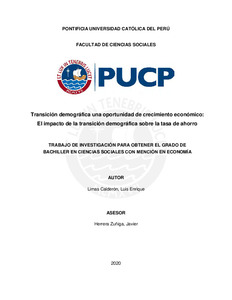| dc.contributor.advisor | Herrera Zúñiga, Javier Ernesto | |
| dc.contributor.author | Limas Calderón, Luis Enrique | |
| dc.date.accessioned | 2021-06-08T21:23:22Z | |
| dc.date.available | 2021-06-08T21:23:22Z | |
| dc.date.created | 2020 | |
| dc.date.issued | 2021-06-08 | |
| dc.identifier.uri | http://hdl.handle.net/20.500.12404/19418 | |
| dc.description.abstract | El Perú se encuentra en una etapa de bono demográfico, el cual es interpretado
como una ventana de oportunidad para el crecimiento económico. En las últimas
décadas, la disminución de la tasa de dependencia, en la literatura previa, ha
sido interpretada como una oportunidad de crecimiento económico y se le ha
otorgado un impacto positivo con respecto a diversos indicadores económicos.
En la literatura internacional, uno de los temas más relevantes con respecto a la
relación de economía y los cambios demográficos es el impacto de la transición
demográfica sobre los niveles de ahorro privado. Por ello, la presente
investigación tiene como objetivo estimar el impacto de la transición demográfica
sobre las tasas de ahorro en el Perú en el periodo 1980-2018. Para estimar el
impacto, la investigación articula distintas teorías que explican la relación entre
los factores demográficos y el nivel de ahorro tales como la Hipótesis de Ciclo
de vida y la Hipótesis de Ingreso Permanente. Además, dado que se pretende
estimar la tasa de ahorro, es preciso señalar que también se requiere de un
análisis de los hechos estilizados de las variables macroeconómicas que son
determinantes de los cambios en la tasa de ahorro, tales como el acceso al
crédito, al crecimiento del PBI per cápita, entre otros. Luego, se abordará la
evidencia empírica tanto internacional como nacional, en la que se expondrá, de
manera cronológica, los distintos aportes de diversas investigaciones. En ese
sentido, la hipótesis que se plantea es que debido al contexto del bono
demográfico en el que se encuentra el Perú, la reducción de la tasa de
dependencia de las últimas décadas contribuya positivamente sobre las tasas de
ahorro privado. La propuesta metodológica está basada en la estimación de
Munozmoreno et al (1998), quienes realizan un análisis de series de tiempo, en
el cual estiman la tasa de ahorro desde un enfoque VAR. | es_ES |
| dc.description.abstract | Peru is at a demographic bonus stage, which is interpreted as a window of
opportunity for economic growth. In recent decades, the decrease in the
dependency ratio, in the previous literature, has been interpreted as an
opportunity for economic growth and has been given a positive impact on various
economic indicators. In the international literature, one of the most relevant issues
regarding the relationship between the economy and demographic changes is
the impact of the demographic transition on private savings levels. Therefore, the
objective of this research is to estimate the impact of the demographic transition
on savings rates in Peru in the period 1980-2018. To estimate the impact, the
research articulates different theories that explain the relationship between
demographic factors and the level of savings such as the Life Cycle Hypothesis
and the Permanent Income Hypothesis. Furthermore, since the savings rate is
intended to be estimated, it should be noted that this research requires an
analysis of the stylized facts of macroeconomic variables that are determinants
of changes in the savings rate, such as access to credit, growth of GDP per
capita, among others. Then, the international and national empirical evidence will
be addressed, setting out, chronologically, the various contributions of various
investigations. In this sense, the hypothesis is that due to the context of the
demographic bonus in which Peru is located, the reduction of the dependency
rate of recent decades contributes positively to private savings rates. The
methodological proposal is based on the estimate of Muñoz Moreno et al (1998),
who perform a time series analysis, in which they estimate the savings rate from
a VAR approach. | es_ES |
| dc.language.iso | spa | es_ES |
| dc.publisher | Pontificia Universidad Católica del Perú | es_ES |
| dc.rights | info:eu-repo/semantics/closedAccess | es_ES |
| dc.subject | Desarrollo económico--Perú | es_ES |
| dc.subject | Transición demográfica--Perú | es_ES |
| dc.subject | Ahorro e inversión--Perú | es_ES |
| dc.subject | Bonos--Perú | es_ES |
| dc.title | Transición demográfica una oportunidad de crecimiento económico: el impacto de la transición demográfica sobre la tasa de ahorro | es_ES |
| dc.type | info:eu-repo/semantics/bachelorThesis | es_ES |
| thesis.degree.name | Bachiller en Ciencias Sociales con mención en Economía | es_ES |
| thesis.degree.level | Bachillerato | es_ES |
| thesis.degree.grantor | Pontificia Universidad Católica del Perú. Facultad de Ciencias Sociales | es_ES |
| thesis.degree.discipline | Ciencias Sociales con mención en Economía | es_ES |
| renati.advisor.cext | 3112001 | |
| renati.advisor.orcid | https://orcid.org/0000-0002-0588-9924 | es_ES |
| renati.author.dni | 71531902 | |
| renati.discipline | 311016 | es_ES |
| renati.level | https://purl.org/pe-repo/renati/level#bachiller | es_ES |
| renati.type | https://purl.org/pe-repo/renati/type#trabajoDeInvestigacion | es_ES |
| dc.publisher.country | PE | es_ES |
| dc.subject.ocde | http://purl.org/pe-repo/ocde/ford#5.02.01 | es_ES |





